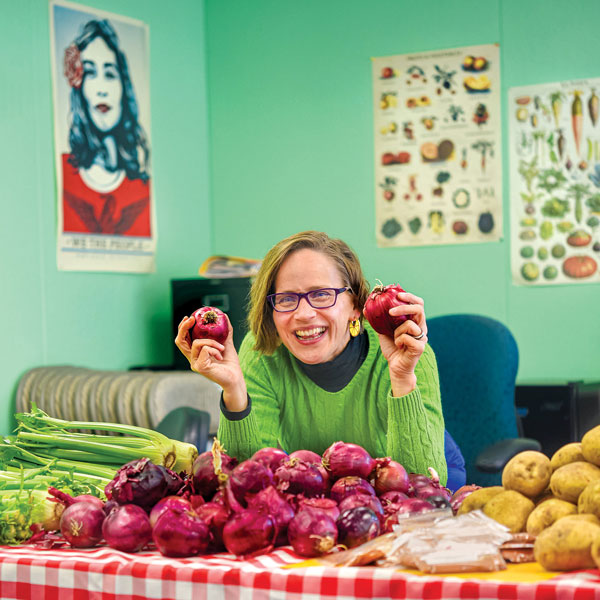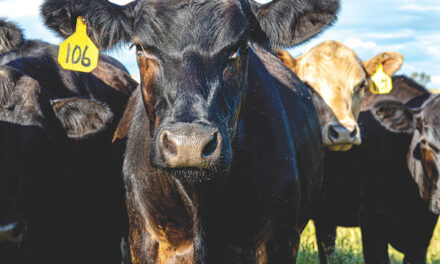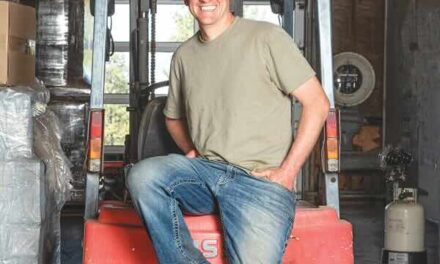Feeding Families
Local and state programs help curb food insecurity
By Tessa Marguerite Outland
January 2021
Food and nutrition insecurity are ongoing struggles for millions in California, including those living in Sacramento. In the highest agriculture-producing state, some local groups and government agencies have created ways to distribute freshly farmed food to families in need.
The Food Literacy Center is a Sacramento nonprofit whose mission is to inspire kids to eat their vegetables. Through its distribution of Veggie STEM Boxes, the center provides families facing food insecurity with meals that are accessible and healthy, while teaching kids about science and math through cooking.

Last April, just a few days after Sacramento City Unified School District schools closed due to COVID-19, the Food Literacy Center began distributing Veggie STEM Boxes. Similar to subscription meals, STEM Boxes include all the ingredients for a healthy recipe. To make broccoli and potato tacos, for example, olive oil, garlic, potatoes, broccoli and tortillas are all packed with a kid-friendly recipe, box of crayons and coloring activity sheet.
An average of about 150 boxes are distributed each week free of charge to elementary school students in Title 1 schools (schools that receive federal funding to help meet educational goals) throughout South Sacramento.
Prior to the pandemic, the Food Literacy Center created a cooking class that used a STEM-based curriculum to teach students food preparation and nutrition. The class incorporated math and science through activities such as measuring ingredients, following a recipe, and learning how fiber and sugar work in the body. After the pandemic hit, the center adapted its weekly curriculum to be available free and online through virtual classes, downloadable lesson plans and recipes. For families without internet at home, Food Literacy Center staff provide printed curriculum.
“We do know this (food insecurity) is going to continue for quite some time,” says Amber Stott, CEO and chief food genius at the Food Literacy Center. “We’re seeing all sorts of statistics from statewide food banks telling us to prepare for the next decade. We’re not going to quickly come out of this.”
Lauren Lathan Reid, director of communications for the California Association of Food Banks, agrees that food insecurity has become even more of a crisis than it was before the pandemic. According to Reid, the number of Californians facing food insecurity has doubled since March 2020. “We now have 10 million hungry Californians and we are not going to return to pre-pandemic levels for potentially 10 years,” Reid says. “I don’t even have a word for it—it’s really bad.”
In Sacramento alone, more than 200,000 people are struggling to keep food on the table for their families, reports California Food Policy Advocates.
CAFB’s program Farm to Family is quenching hunger while reducing agricultural excess. The program partners with farmers, ranchers, packers and shippers to get farm products from the field to food banks. Started by Bay Area food banks in the late 1990s, the program has been operated by CAFB since 2005. Farmers can donate products to the association and receive a small reimbursement that helps cover distribution costs.
In 2020, Farm to Family distributed more than 153 million pounds of produce and 12 million pounds of items such as eggs, milk and cheese to its 42 partners across the state, including Sacramento Food Bank & Family Services.
Reid says the California Department of Food and Agriculture contacted the association in early 2020 to assist with the imminent instability of the food supply chain. Since many farms distribute directly to restaurants or hospitality services, they were suddenly faced with an overabundance of produce when the pandemic forced widespread closures. As more farmers became aware of the Farm to Family program, many chose to donate their excess harvest to nourish California’s hungry community members. “This way high-quality produce goes to hungry people instead of being wasted,” Reid says.
In April 2020, Farm to Family distributed 18 million pounds of produce—probably the largest bounty in one month since the program’s beginning, according to Reid. The association received financial support from the government that helped reduce fees for labor and transportation. Normally, in order to receive produce through the Farm to Family program, each food bank would be responsible to pay the fees. “So food banks were able to get the produce free of charge to get what they need, not just what they could afford,” Reid adds.
Farm to Family currently partners with more than 200 farms across California. Without produce donations from all these farmers, the program would not exist. “It’s a real partnership between our food banks and the agriculture community,” Reid says.
Whether it’s feeding families around the corner or across the state, programs like Veggie STEM Boxes and Farm to Family are vital to our communities in the effort to curb food insecurity.
For more information, visit foodliteracycenter.org and cafoodbanks.org/farm-family.
Tessa Marguerite Outland can be reached at tessa.m.outland@gmail.com. Follow us on Facebook, Twitter and Instagram: @insidesacramento.
















